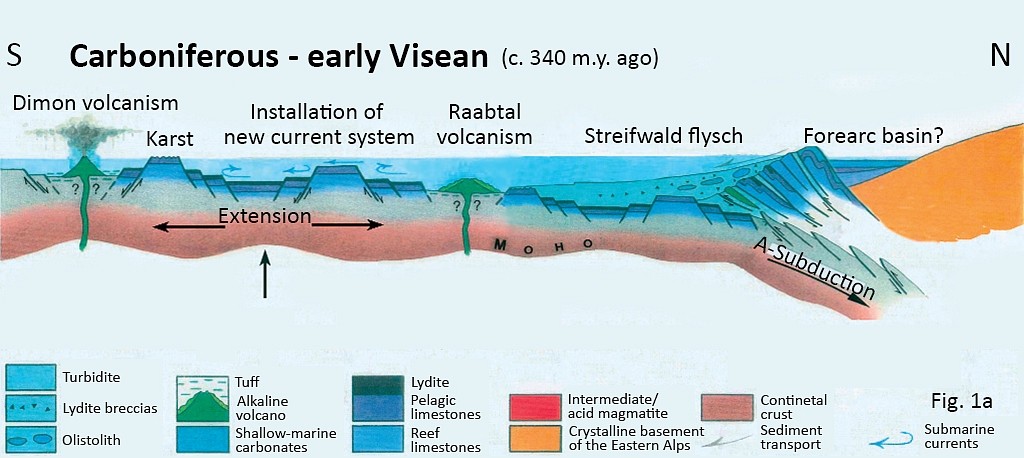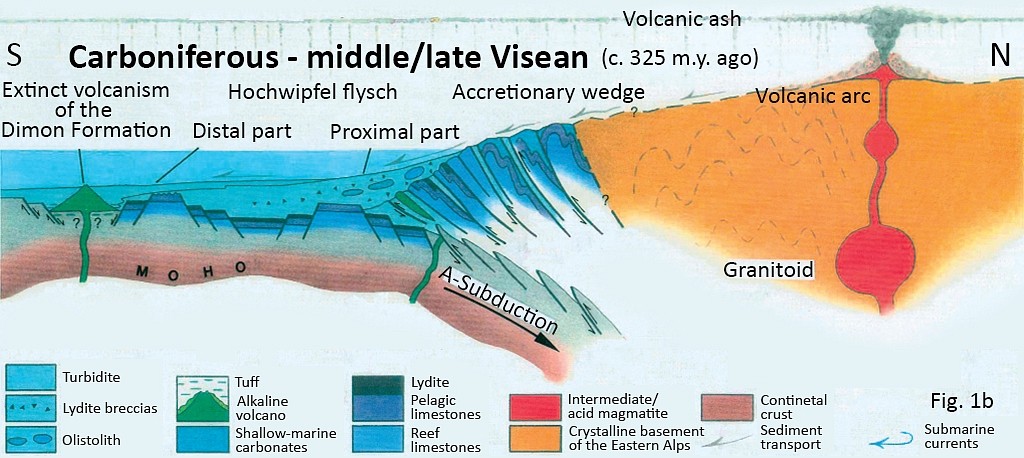FEATURED AND RECENTLY ADDED FOSSILS
Naziv vsebine
Geodynamic Evolution of the Varsican Orogeny

Sigmoidal tension gash infilled with quartz precipitate within bedded Pennsylvanian/ Early Permian limestone. Javorniški rovt.
The lithologically similar Carnic Alps and Southern Karavanks are considered part of the southern belt of the European Variscides (Mader & Neubauer, 2004 and references therein), that was extensively deformed by the collisional tectonics that gave rise to the Alps.
The Variscan orogeny was a long lasting (Devonian - Early Permain) polyphase process, involving the heterochronous amalgamation of microcontinets and terranes detached from two major continets, namely Laurussia and Gondwana, and their docking to the southern margin of Laurussia prior to its final collison with Gondwana (e.g. Sampfli et al., 2002; McCann et al., 2006; von Raumer & Stampfli, 2008; Sampfli et al., 2011, 2013). Kroner & Romer (2013) reject the complex models involving numerous microplates sandwiched between Gondwana and Laurissa and propone two-major-plates-only collision scenario, according to which the Rheic ocean spreading led to intracontinental extension and the formation of expanded shelf areas on both sides of the evolving Ocean. Heterogenous-extension-affected shelf areas adjacent to Gondwana (S) and Avalonia (N) - the latter eventually merged with Laurentia & Baltica into Laurussia - consisted of stable continental blocks separated by zones of thinned continental crust, behaving during the Variscan collisional tectonics in an unsubductable and subductable manner, respectively.
The Variscan Orogeny in the South Alpine Carnic Alps and Southern Karavanks started in the Visean, reaching its climax during the late Bashkirian or early Moscovian when the main deformation may have taken place. Based on available geological data and the plate-tectonics-based model developed by Laufer et al. (1993), the Variscan orogeny at the interface of the Eastern Alps and the South Alpine Carnic Alps and Southern Karavanks can be summarized as follows:
- Following the rifting-initiation (? back-arc spreading) in Late Ordovician, evidenced by bimodal volcanic relics in the W. Carnic Alps, extensional tectonics and sedimentation on a passive continental margin continued throughout the Silurian and Devonian until the onset of subduction in the Visean, when the former passive margin was transformed into an active margin of a collisonal zone.
- The advancing extension, reaching its peak in the upper Late Devonian to lower Early Carboniferous, eventually resulted in a rifting episode and the emplacement of pre- and synorogenic intraplate basalts of the Raabtal (W Carnic Alps) and slightly younger Dimon formation (E Carnic Alps), before the initial stages of subduction in the pre-late Visean (Laufer et al., 1993; 2001 Hubich et al. 1999). Schonlaub & Forke (2007) and Forke (2009) attribute crustal thinning and rifting to the slab-pull-generated extension in the downgoing plate during the incipient subduction in the early Visean (Fig 1a).
- North-directed subduction lead to an extensional regime south of the subduction zone and uplift of a peripheral bulge exposed to local karstification and erosion (Fig 1a).
- Fossiliferous peritidal carbonate deposits on the shelf areas surrounding the northern active margin (fore-arc basin?) were incorporated into the accretionary wedge, reworked, and completely destroyed in the process (Fig 1a).
- The subduction of oceanic or thinned continental crust under the active continental margin, preserved as metamorphic domains of the Eastern Alps north of the Periadricatic Fault System, triggered diachronous southward shifting turbidite sedimentation of Streifwald (northernmost, oldest), Cellon-Kellerwand and Hochwipfel flysch (southernmost, youngest) by the middle Visean (Fig 1a,b).
- At the time of the deposition of the Hochwipfel flysch, plate convergence entered the collisonal phase, causing increased hinterland-uplift indicated by large olistoliths outsizing those of older flysch basins to the north. South of the collision zone, a deep-water trough was supplied from a northern source area with more than 1500 m thick flysch-type deposits of the Hochwipfel Formation, and huge olistoliths of older pre-flysch rocks, mostly Devonian to Early Carboniferous limestones detached from the accretionary wedge, slid down into the deepening trench (Fig 1b).
- Sedimentation probably ceased during the middle or upper Bashkirian stage. The advancing subduction and collision (late Bashkirian or early Moscovian) led to complete closure of the sedimentary basin, followed by uplifting accompanied by thrusting forming south verging fold and thrust belt in the final stage of the Variscan Orogeny (Laufer et al., 1993; 2001; Hubich et al., 1999; Forke et al, 2006; Schonlaub & Forke, 2007, Forke 2009; and references therein).


Figs 1 a, b: illustrate the geodynamic evolution in the Early Carboniferous between the present day South Alpine Carnic Alps and Southern Karavanks south of, and Eastern Alps north of the collisonal zone (after Schonlaub & Forke, 2007; modified after Laufer et al., 1993). An "A- subduction" is assumed i.e. a subduction of one continental lithospheric plate under another as no oceanic crust relics from that period outcrop in the region. The timing of the igneous Dimon Formation, interpreted as underlying, overlaying, or being lateral equivalent of the Hochwipfel Formation (e.g. Laufer et al., 1993; Brime et al., 2008; Venturini & Spalletta, 2015), remains highly disputed. The interpretation of Laufer et al. (1993), assuming Dimon volcanism preceded deposits of the Hochypfel flysh, is depicted.


